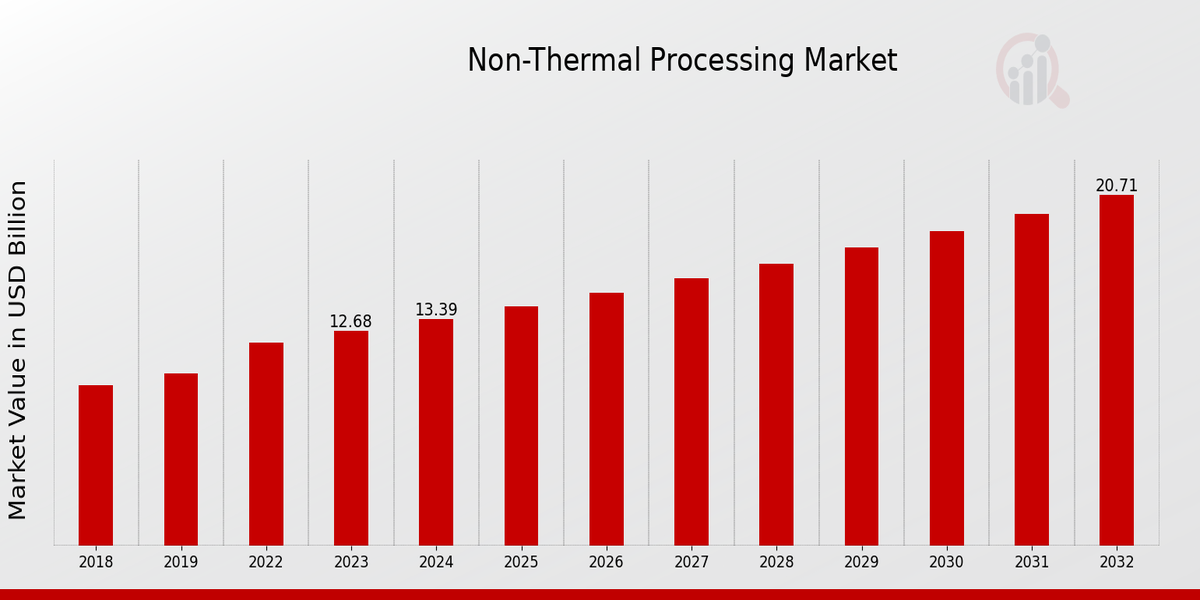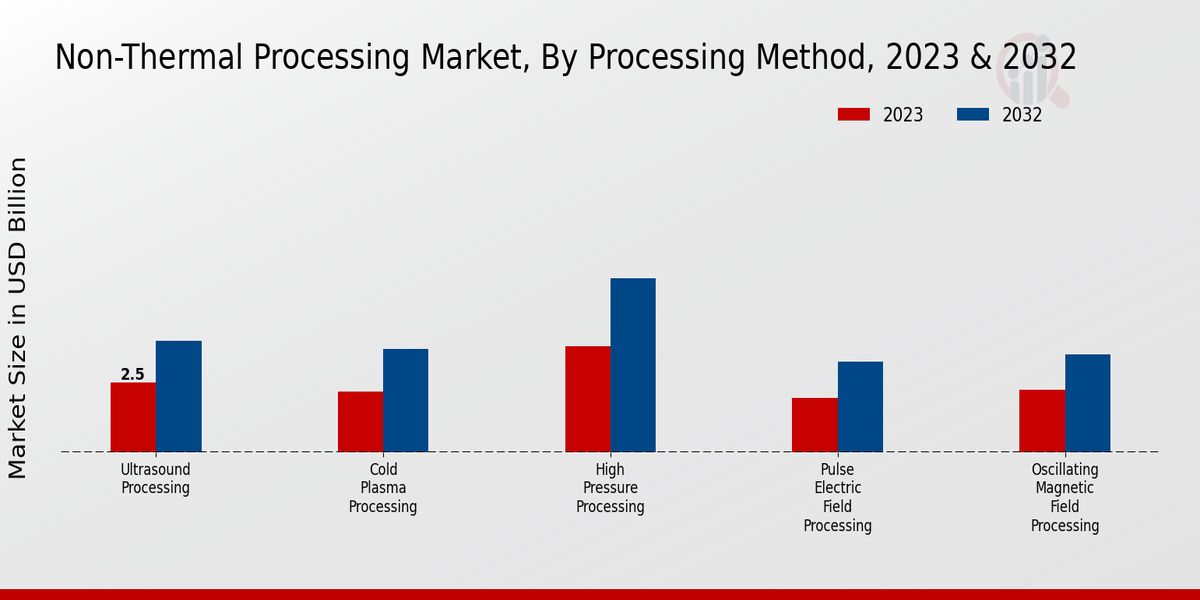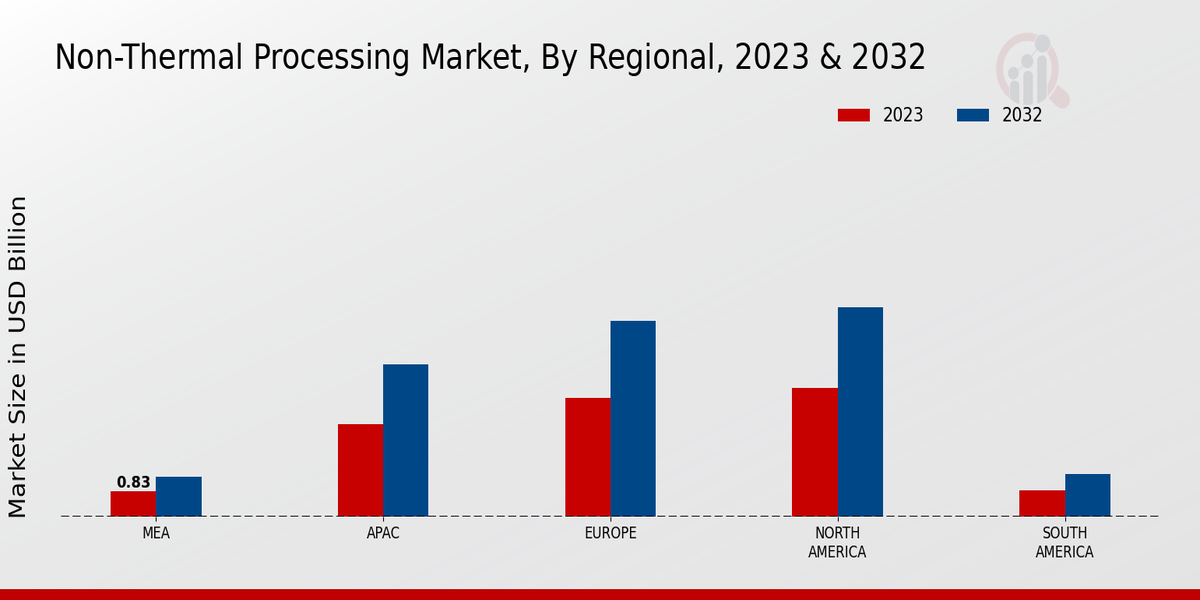Non Thermal Processing Market Overview
Non Thermal Processing Market Size was estimated at 12.01 (USD Billion) in 2022.The Non Thermal Processing Market Industry is expected to grow from 12.68(USD Billion) in 2023 to 20.7 (USD Billion) by 2032. The Non Thermal Processing Market CAGR (growth rate) is expected to be around 5.6% during the forecast period (2024 - 2032).

Source Primary Research, Secondary Research, Market Research Future Database and Analyst Review
Key Non Thermal Processing Market Trends Highlighted
The Non Thermal Processing Market is gaining momentum due to several key market drivers, including the increasing demand for food safety and quality, the rising consumer preference for natural and minimally processed food products, and the need for longer shelf life without compromising nutritional value. Technological advancements in non-thermal methods, such as high-pressure processing, pulsed electric fields, and ultraviolet light, are further propelling the market forward.
These innovative processing techniques not only preserve the food’s sensory attributes but also enhance its nutritional profile, making them attractive to both manufacturers and consumers alike.Opportunities to be explored in the market include expanding applications in various sectors, such as beverages, dairy, and ready-to-eat meals. The growing inclination towards clean-label products presents a significant avenue for companies to develop non-thermal solutions that meet consumer expectations for transparency and health benefits.
The Asia-Pacific region, in particular, is witnessing substantial growth potential as rising disposable incomes and urbanization lead to an increased demand for preserved food products.Trends observed in recent times include a surge in investments towards research and development of more efficient non-thermal technologies, along with a stronger focus on sustainability practices in food processing. There is also a notable shift towards e-commerce and direct-to-consumer distribution channels, influenced by changing consumer behaviors, particularly post-pandemic.
As the market continues to evolve, businesses are increasingly recognizing the importance of adopting innovative processing technologies that align with both health-conscious consumer trends and environmental sustainability goals, ensuring a bright future for the Non Thermal Processing Market.
Non Thermal Processing Market Drivers
Increasing Consumer Demand for Food Safety and Quality
One of the foremost drivers of growth in the Non Thermal Processing Market Industry is the surging consumer demand for food safety and quality. As awareness regarding foodborne illnesses and contamination increases, consumers are becoming more vigilant about the products they purchase.
Non-thermal processing methods, such as High Pressure Processing (HPP), Cold Plasma, and Pulsed Electric Field, among others, help in retaining the nutritional and sensory qualities of food while extending its shelf life and minimizing the risks associated with pathogens.With consumers increasingly opting for healthier, minimally processed foods, companies are gravitating towards non-thermal processing techniques as a solution to meet consumer expectations for fresher and safer products. These methods also align well with plant-based formulations, which have seen a significant rise in popularity.
The demand for transparency in food labeling further drives the trend, as consumers become more interested in the methods employed for food processing.As this phenomenon continues to shape purchasing behavior, it presents a favorable outlook for companies involved in non-thermal processing, thereby accelerating market growth. In summary, the emphasis on food safety, quality assurance, and nutrition retention is pivotal in driving the expansion of the Non Thermal Processing Market Industry.
Technological Advancements in Processing Techniques
The advancement of technology in non-thermal processing techniques is a significant driver for growth in the Non Thermal Processing Market Industry. Innovations such as microwave processing, ultraviolet light treatment, and ultrasound technology are being increasingly adopted for preserving food without compromising its quality. These modern techniques enhance operational efficiency, lower energy consumption, and minimize waste, appealing to manufacturers who are under constant pressure to optimize production processes while reducing costs.This technological evolution increases the overall appeal of non-thermal methods, making them a priority in food processing operations.
Government Regulations and Compliance for Food Safety
Government regulations aimed at ensuring food safety and compliance are playing a crucial role in the non-thermal processing market. Authorities worldwide are tightening the regulations surrounding food processing practices, particularly those associated with treatment, to eliminate pathogens and maintain quality. By implementing stringent safety standards, regulatory bodies are indirectly promoting the adoption of non-thermal processing technologies, which comply more effectively with current safety norms.As a result, food manufacturers are increasingly investing in these innovative safety measures to mitigate risks, paving the way for robust growth in the Non Thermal Processing Market Industry.
Non-Thermal Processing Market Segment Insights
Non-Thermal Processing Market Processing Method Insights
The Non-Thermal Processing Market is projected to achieve a value of 12.68 USD Billion in 2023 and is set to grow significantly over the next years. Within this market, the Processing Method segment plays a critical role, showcasing various innovative techniques that enhance product preservation while maintaining quality.
Notably, High Pressure Processing stands out as a prominent method, valued at 3.8 USD Billion in 2023 and expected to increase to 6.25 USD Billion by 2032, which indicates its significant application in the food and beverage sector due to its ability to kill pathogens effectively without compromising on nutrients.Ultrasound Processing is also gaining traction, with a value of 2.5 USD Billion in 2023 and a projected growth to 4.0 USD Billion in 2032, highlighting its efficacy in reducing processing time and improving extraction rates in food applications.
Cold Plasma Processing has a valuation of 2.18 USD Billion in 2023 and is forecasted to reach 3.7 USD Billion by 2032; this method is recognized for its effectiveness in sterilization and surface modification, particularly in packaging materials to enhance shelf-life.
Pulse Electric Field Processing is valued at 1.95 USD Billion in 2023 and is anticipated to rise to 3.25 USD Billion by 2032, showing promise in juice processing and dairy applications thanks to its ability to improve product quality and yield.Similarly, Oscillating Magnetic Field Processing holds a market value of 2.25 USD Billion in 2023, with expectations to grow to 3.5 USD Billion by 2032; this method is particularly significant for its potential in enhancing the safety and quality of food products through non-destructive processes.
Each method offers unique advantages that cater to various industry needs, which contributes to the diverse landscape of the Non-Thermal Processing Market revenue, showcasing a clear distinction in their market share and growth trajectories.
The continuous advancement in these Processing Methods is propelled by the increasing demand for sustainable and efficient food processing technologies, thus presenting a robust opportunity for market growth and innovation in the coming years.As industry players explore these techniques further, they aim to meet the changing consumer preferences and regulatory requirements, positioning the Non-Thermal Processing Market workforce for future developments that are both economically viable and environmentally friendly.

Source Primary Research, Secondary Research, Market Research Future Database and Analyst Review
Non-Thermal Processing Market Application Insights
The Non-Thermal Processing Market is valued at 12.68 USD Billion in 2023, showcasing its growing relevance across various applications. Segmenting the market reveals a strong focus on areas such as Food Preservation, Pharmaceutical Processing, Nutraceuticals, Water Treatment, and Cosmetic Products. Food Preservation plays a critical role in enhancing shelf life while maintaining quality, making it a major player within this market. Pharmaceutical Processing leverages non-thermal technologies to ensure effective product integrity and safety, driving significant advancements in drug formulations.Nutraceuticals are gaining popularity for their health benefits, further boosting market growth.
Water Treatment has emerged as essential for ensuring safety and sustainability in water purification processes. Lastly, Cosmetic Products utilize non-thermal methods to preserve active ingredients, thus playing a vital role in the industry’s innovation. As these segments evolve, the Non-Thermal Processing Market continues to reflect trends towards sustainability, efficiency, and enhanced product quality, significantly influencing overall market dynamics and contributing to the growing Non-Thermal Processing Market revenue and data insight.Market growth is further driven by increasing consumer awareness about health and safety standards, alongside the need for innovative processing methods.
Challenges such as regulatory compliance and the high initial cost of technology remain, but opportunities for expansion in emerging markets present a positive outlook for the industry.
Non-Thermal Processing Market End User Industry Insights
The Non-Thermal Processing Market is projected to be valued at 12.68 billion USD in 2023 and is poised for steady growth, driven largely by the diverse demand from various industries. Within the End User Industry segment, there is considerable activity in the Food and Beverage sector, known for its substantial adoption of non-thermal processing techniques to enhance food safety and prolong shelf life without compromising quality.
The Pharmaceutical industry also plays a significant role, utilizing non-thermal methods to preserve active ingredients in products effectively.Meanwhile, the Cosmetics and Personal Care sector increasingly embraces these processes to maintain product efficacy while meeting consumer demand for natural and gentle formulations. Additionally, the Agriculture industry is witnessing growth through improved processing of agricultural products, aiming for sustainable practices. Environmental Services benefit from non-thermal processing technologies that support waste management and pollution control.
The growth of these sectors underlines the crucial role of the Non-Thermal Processing Market industry, highlighting its potential for market growth and increased application in diverse areas.As of 2024, the forecast suggests an expected upward trajectory in market statistics, further solidifying the importance of each sector in driving overall market dynamics.
Non-Thermal Processing Market Equipment Type Insights
The Non-Thermal Processing Market, valued at approximately 12.68 USD Billion in 2023, reflects a robust landscape focused on various equipment types, including Batch Processors, Continuous Processors, and Mobile Processors. Each of these plays a vital role in enhancing food safety and preserving quality while maintaining nutritional value. Batch Processors often dominate the market due to their flexibility and ability for small-scale production, making them essential for artisanal and specialty food products.
Continuous Processors are gaining traction, especially in large-scale food manufacturing, where efficiency and consistent quality are crucial.Mobile Processors are also emerging as significant contributors, allowing for on-site processing, which meets growing consumer demands for freshness and localization. Ongoing advancements in technology are expected to create numerous opportunities for these equipment types, addressing the challenges of food waste and enhancing energy efficiency. The Non-Thermal Processing Market segmentation reveals a future aligned with sustainability and innovative processing techniques, positioning it for further growth as the market evolves.
Non-Thermal Processing Market Regional Insights
The Non-Thermal Processing Market is segmented regionally into North America, Europe, South America, Asia Pacific, and the Middle East and Africa, showing a comprehensive landscape of opportunities and challenges. In 2023, North America holds a significant position with a market valuation of 4.15 USD Billion, reflecting its advanced food processing infrastructure and innovation drive. Europe closely follows, valued at 3.85 USD Billion, driven by stringent food safety regulations and rising consumer demand for processed food alternatives.
Asia Pacific, valued at 3.0 USD Billion, is emerging rapidly due to increasing population and urbanization, indicating a growing appetite for convenient food solutions.Conversely, the Middle East and Africa account for a smaller market share at 0.83 USD Billion, but it is witnessing growth as local industries modernize. South America stands at 0.85 USD Billion, facing challenges related to economic fluctuations but with potential for expansion in the food processing sector. Collectively, these regions contribute to the evolving dynamics of the Non-Thermal Processing Market, balancing between technological advancements and regional consumer preferences.

Source Primary Research, Secondary Research, Market Research Future Database and Analyst Review
Non Thermal Processing Market Key Players And Competitive Insights
The Non Thermal Processing Market is characterized by a dynamic landscape where various companies showcase innovative techniques and solutions aimed at preserving the quality and safety of food products without relying on excessive heat. In this market, differentiation often hinges on technology advancements, regulatory compliance, and consumer trends favoring minimally processed foods that retain their natural flavors, nutrients, and textures. Competitors are continually evolving their strategies to not only address the growing demand for non-thermal processes but also to meet the increasingly stringent safety standards imposed by various regulatory bodies.
This has spurred investments in research and development, enabling market players to offer cutting-edge technologies such as high-pressure processing, pulsed electric field processing, and cold plasma treatment. Furthermore, the rise of e-commerce and health-conscious consumers has pushed companies to optimize their supply chains, ensuring that the benefits of non-thermal processing reach a broader audience while maintaining sustainability.Kraft Heinz holds a significant position within the Non Thermal Processing Market, predominantly focusing on leveraging advanced processing technologies to enhance product safety and extend shelf life without compromising on flavor and nutrition.
The company emphasizes its commitment to sustainability and innovation, which aligns with current consumer preferences for health-oriented products. Kraft Heinz possesses robust distribution networks and a well-established brand presence, capitalizing on its vast portfolio to introduce non-thermal processed food items that cater to diverse consumer segments. Its strengths lie in extensive research partnerships and a proactive approach in adopting non-thermal techniques that resonate with the increasing demand for convenience and nutritious food options.
Moreover, the synergy between its marketing strategies and product offerings enables Kraft Heinz to maintain a competitive edge, appealing to health-conscious consumers while continuing to explore new avenues for growth.Unilever is another formidable player in the Non Thermal Processing Market, recognized for its dedication to sustainability and innovation. The company actively integrates non-thermal processing methods into its product lines, promoting products that are not only safe and nutritious but also environmentally friendly. Unilever's strengths include an extensive reach, with strong market penetration across various regions, allowing for efficient distribution of its non-thermal processed food items.
The company invests significantly in consumer research to understand evolving preferences, ensuring that its offerings meet the demand for organic and minimally processed foods. Furthermore, Unilever’s commitment to developing sustainable practices resonates well with the increasing number of consumers prioritizing ethical food choices. Through strategic partnerships and agile operations, Unilever continues to enhance its position in the market, focusing on innovation to deliver high-quality products that align with contemporary consumer values.
Key Companies in the Non Thermal Processing Market Include
Non-thermal Processing Market Industry Developments
-
Q2 2024: Symbios Technologies announced a partnership with a major food manufacturer to implement HPP in their production process. Symbios Technologies entered into a partnership with a major food manufacturer to deploy high-pressure processing (HPP) technology in their production line, marking a significant business development in the non-thermal processing sector.
-
Q1 2023: Hiperbaric launched a new line of HPP systems for the beverage industry. Hiperbaric, a leading provider of high-pressure processing equipment, introduced a new product line specifically designed for beverage applications, expanding its portfolio in the non-thermal processing market.
-
Q4 2023: New regulations regarding irradiation of certain food products were enacted in the European Union. The European Union implemented new regulatory standards for the irradiation of specific food products, directly impacting the adoption and compliance requirements for non-thermal processing technologies in the region.
Non Thermal Processing Market Segmentation Insights
Non-Thermal Processing Market Processing Method Outlook
- Pulse Electric Field Processing
- Oscillating Magnetic Field Processing
Non-Thermal Processing Market Application Outlook
- Pharmaceutical Processing
Non-Thermal Processing Market End User Industry Outlook
- Cosmetics and Personal Care
Non-Thermal Processing Market Equipment Type Outlook
Non-Thermal Processing Market Regional Outlook
| Report Attribute/Metric |
Details |
| Market Size 2022 |
12.01(USD Billion) |
| Market Size 2023 |
12.68(USD Billion) |
| Market Size 2032 |
20.7(USD Billion) |
| Compound Annual Growth Rate (CAGR) |
5.6% (2024 - 2032) |
| Report Coverage |
Revenue Forecast, Competitive Landscape, Growth Factors, and Trends |
| Base Year |
2023 |
| Market Forecast Period |
2024 - 2032 |
| Historical Data |
2019 - 2023 |
| Market Forecast Units |
USD Billion |
| Key Companies Profiled |
Kraft Heinz, Unilever, Thyssenkrupp, Krones, Tetra Pak, Xylem, PepsiCo, Sidel, Merck Group, Ecolab, Clextral, Cold Pressure Technology, Nestle, Avure Technologies, Hiperbaric |
| Segments Covered |
Processing Method, Application, End User Industry, Equipment Type, Regional |
| Key Market Opportunities |
Increased demand for clean labels Rising consumer health consciousness Expansion in food safety regulations Technological advancements in processing Growth in plant-based food products |
| Key Market Dynamics |
Increasing demand for food preservation Growing awareness of food safety Advancements in processing technologies Rising consumer preference for clean-label products Government regulations promoting nonthermal methods |
| Countries Covered |
North America, Europe, APAC, South America, MEA |
Frequently Asked Questions (FAQ):
The Non Thermal Processing Market is expected to reach a value of 20.7 USD Billion by 2032.
The expected CAGR for the Non Thermal Processing Market is 5.6 percent from 2024 to 2032.
North America holds the largest market share in the Non Thermal Processing Market, valued at 4.15 USD Billion in 2023.
The High Pressure Processing segment is expected to be valued at 6.25 USD Billion by 2032.
Major players in the Non Thermal Processing Market include Kraft Heinz, Unilever, PepsiCo, and Tetra Pak.
The Ultrasound Processing segment is valued at 2.5 USD Billion in 2023.
The market for Non Thermal Processing in Europe is projected to be valued at 6.31 USD Billion in 2032.
The Cold Plasma Processing segment is estimated to be valued at 3.7 USD Billion in 2032.
The APAC region is expected to reach a market value of 4.93 USD Billion by 2032.
The Pulse Electric Field Processing segment is valued at 1.95 USD Billion in 2023.

















